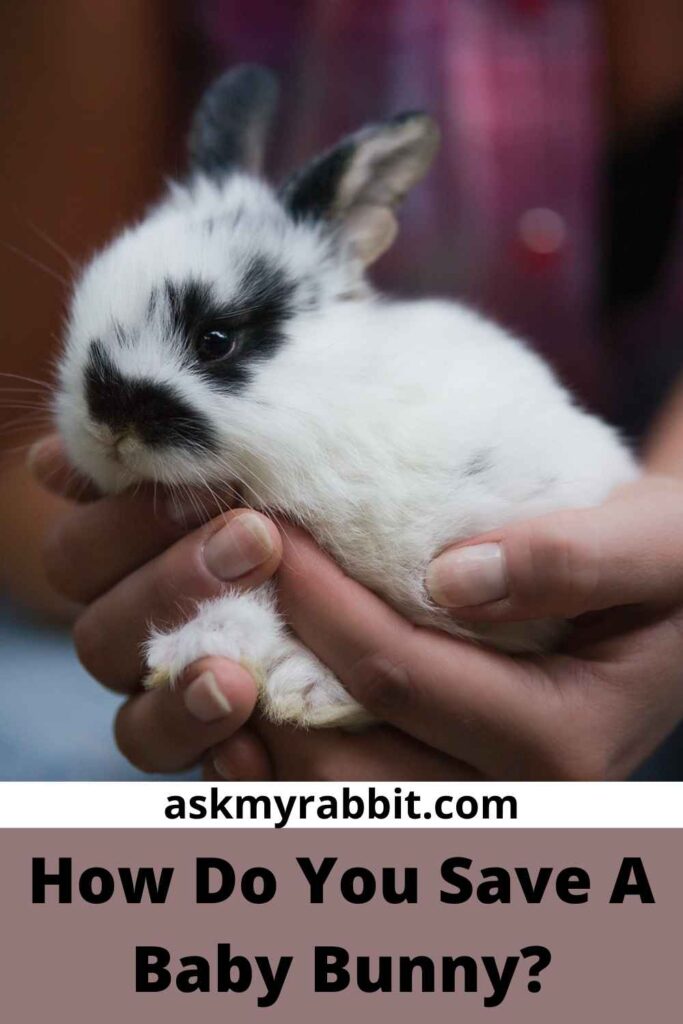The majority of newborn rabbits in the wild are not orphaned. While it’s natural to want to ask for aid, it’s not always required. A doe will never forsake her young on her own will. The only reasons a mother rabbit wouldn’t be around are death or environmental difficulties that prevent access to the nest.
In order to save a baby bunny from dying, you need to keep him warm. The body temperature of a newborn rabbit is greater than ours. In order to thrive, bunnies need warmth. They will feel sick and perhaps cease moving if they become too chilly too rapidly.
Protect your baby rabbit from harsh cold and heat as it gets older. Rabbits are unable to sweat or pant and hence cannot effectively disperse heat. As a consequence, excessive temperatures may cause hyperthermia. This can be fatal to a baby bunny’s health.
For the first two weeks of its life, a rabbit will only eat milk. A rabbit will begin eating solids at the age of two weeks. The baby will consume the same food as its mother from the age of four weeks.
Milk, on the other hand, will continue to play an important role in the diet for the first six weeks. Therefore, make it a regular element of the bunny’s diet.
In this article, we will inform you all about saving a baby bunny from dying. So, keep reading!

What To Do If A Newborn Rabbit Is Dying?

In order to save a newborn rabbit from dying, you may attempt a few different methods to safely warm him up. Rabbits do not retrieve or transfer their offspring. The furless newborn rabbit will not be able to survive without human assistance.
Begin by examining the newborn rabbit. If the bunny is warm and moving about, it is okay. Also, do not assume the kit is dead just because it is chilly or cold to the touch. When their temperature lowers, bunnies stay extremely motionless. This is to save energy, allowing them to survive as long as possible.
While you may just need your own warm skin to assist the young rabbit restore its body heat, you should be prepared to conduct the following extra measures. You may need the use of certain supplies:
- Towels
- Pad for heating
- Dryer
- A bowl of warm water
If a newborn rabbit is dying and you want to save him, we recommend that you follow these steps:
1. Use Body Heat
The first thing you may do is slip the kit beneath your shirt on your warm skin. The infant should start to warm up right away. You could even see its feet begin to move.
2. Use A Heating Pad
To keep the tiny baby bunny warm, use a heating pad. Wrap the pad in a towel and set the temperature to the lowest possible. Place the rabbit, heating pad, and towel inside a shoebox.
This is so the heat can surround your baby bunny. Slowly warming up the rabbit is great. Don’t give in to the impulse to crank up the volume on the pad.
The skin of a baby is very vulnerable to burns. Do not leave the heating pad alone with the rabbit. Check the pad on a frequent basis to make sure it isn’t becoming too hot. Place the baby back with its littermates after it has warmed up and is moving.
3. Give Bath
Another method is to fill a dish with warm water and set it on the counter. Place the kit in a storage bag and leave the top open and secure. Place the storage bag in the water bath with the baby resting against the warm water inside.
The aim is to let the warm water heat the kit’s skin via the plastic bag rather than letting the water contact it.
4. Use Towels That Are Warm
You may also put hand towels in the dryer. Hold the kit in your hands with the towel wrapped around it after they’ve warmed up.
Wrap the young rabbit in another warm towel from the dryer after the hand towel has cooled. Do this until the rabbit pinks up and is warm enough to be removed from the towels.
Even when a newborn is brought back from the edge of death, it may gape, gasp, and expire. This is despite the fact that it seemed that you were able to warm it up. You have to accept that you tried all you could.
How Do You Save A Baby Bunny?

Check to determine whether the orphaned young rabbit you discovered is still breathing. If it isn’t moving, it’s probably too late to rescue the rabbit if its head is arched back and its mouth is open. If the rabbit hasn’t reached this point, though, it is possible to revive it.
In order to save a baby bunny, the first step is to keep the animal warm. This is particularly if it is chilly to the touch. To transmit your body heat, keep it near to you or cover it in a soft hand towel. Do it until it begins to wiggle and show signs of life.
Place the rabbit back with his littermates to recover after it has perked up. If there are many rabbits, they will cluster together for warmth. Otherwise, use safe means to offer additional heat to assist the rabbit maintain a healthy body temperature.
Place the rabbit back into the nest and cover it with grass if the mother is still alive and you’ve followed the prior instructions. The mother will not forsake the chicks if you touch the nest. She will instead return to feed them as nature intended.
How To Save A Wild Baby Bunny From Dying?
Wild baby bunnies are reared in tiny, shallow nests among woods or in the open. While an open location may seem to be a risky site for a rabbit to establish a nest, predators are less likely to wander into exposed places. When you come to a nest, seeing a number of newborn bunnies alone is alarming.
You must first ascertain if the mother rabbit is there in order to keep a wild newborn rabbit alive. Mother rabbits only come back to the nest to feed their babies twice a day. If they’re orphaned, you’ll need to build a nest for them and keep them warm.
You will also need to feed them nutritious food and need to encourage urine and feces, as well as find healthy cecotropes. Injured rabbits will need quick medical attention.
Only around ten percent of orphaned wild rabbits survive for more than a week. Attempts to care for orphaned bunnies can do more damage than good. Therefore, approach with caution if you come upon a nest without a mother. You don’t want to become involved until you’re certain that your assistance will make a difference.
What Do I Feed Baby Bunnies?
Kitten Milk Replacer (KMR) or goat milk should be fed to baby rabbits. We recommend that you add one tablespoon of hundred percent heavy whipping cream (no sugar) to each can of KMR. This is because rabbit milk is the most caloric of all mammals.
Store-bought baby animal bottles won’t work for most kits. To avoid the risk of infection, use an oral syringe that has been sterilized.
It’s preferable to feed newborn bunnies no more than twice a day. Although, it may take a few more feedings to get an acceptable quantity into them.
The quantity you feed depends on the breed of rabbit you’re feeding and the size of the kit. However, there’s a general estimate for feeding a domestic rabbit that will grow to reach around five to six pounds as an adult. For bigger breeds, increase the quantity as required.
Go to your local health food shop and acquire a bottle of Acidophilus. This is to assist the kits retain healthy gut flora. Request the capsules with the grainy stuff inside. This is in order to incorporate a little amount into the formula with each feeding.
How Do I Take Care Of A Baby Rabbit?

While resting on their backs, baby rabbits feed from their mothers. Wrap a soft face cloth or hand towel around the bunny. Then place the cloth on your lap or in the crook of your arm.
If the rabbit refuses to eat in this manner, do the best you can. Allowing the baby to feed at its own rate is critical, particularly if it is not happily sucking from the syringe. If you inject the liquid in too soon, the liquid will aspirate into the rabbit’s lungs. This may cause the bunny to die.
To keep the digestive tract and urinary system working properly, make the rabbit defecate and urinate after each meal until their eyes open. Gently rub the vaginal region with a soft cloth or a cotton ball wet with warm water until the rabbit begins to produce feces and pee.
Stroke the rabbit till it comes to a halt. You’re imitating the mother rabbit’s action of licking her young to encourage them to excrete. The stool will be comfortable and come in a variety of green and yellow hues.
If the urine is dark and gritty, the bunnies are dehydrated and should visit a veterinarian. To avoid milk drying in the hair, wipe the baby’s lips with a moist cloth or paper towel.
Around the age of ten days, the eyes of a baby rabbit opens. At this time, you may start giving them hay and pellets. However, do not give them vegetables or fruits. Simply place timothy, orchard, and alfalfa hay and pellets in a corner of the box where the babies can reach them.
Make sure the pellets are unsweetened, rich in fiber, and fresh. It should have no extra ingredients like dried banana chunks or seeds. Never leave a deep water dish where a baby may drown. Instead, use a shallow dish that you can clean and refill periodically.
Frequently Asked Questions
How Do You Know If A Newborn Rabbit Is Dying?
Refusing to eat, trouble breathing, or an abrupt change in vital signs are all symptoms that a rabbit is approaching death. A rabbit’s body temperature should be between hundred and hundred and four degrees Fahrenheit.
How Long Can Baby Rabbits Live Without Milk?
Baby rabbits can only last three to four days without eating milk. In the wild, most newborn bunnies are only fed once a day. Rabbits, unlike many other animals, do not nurse their young immediately after birth. Instead, their mother feeds them the next night.
What Do You Feed A Baby Rabbit Without A Mother?
Kitten Milk Replacer (KMR) or goat milk, may be fed to a baby rabbit without a mother. This may be purchased at pet shops or even a local veterinarian’s office.
Final Words
Taking care of wild young bunnies is a difficult chore that demands round-the-clock attention. Novice bunny parents should avoid attempting any kind of treatment without first seeking professional counsel.
The bunnies are unlikely to live without their mother if they become orphaned. Some newborn rabbits, on the other hand, need just a helping hand.
We hope that this article has been able to provide all the information required in order to save a dying bunny. If you have any more queries or doubts, drop them in the comment section below. We will answer them soon!







